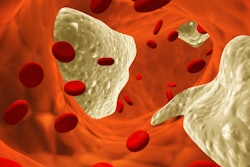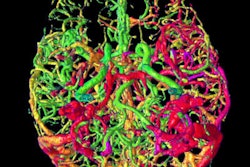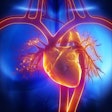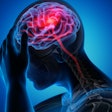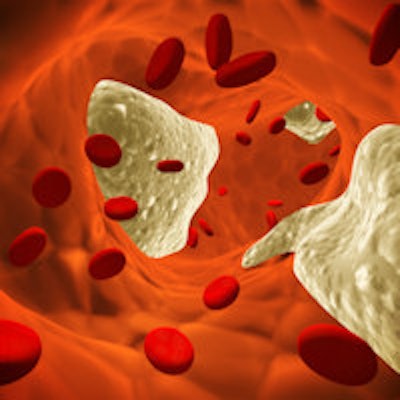
Choosing acute stroke patients for reperfusion therapy means identifying their TRAIT -- that is, their treatment-relevant acute imaging target, according to a talk on Thursday at the International Society for Computed Tomography (ISCT) 2016 Symposium in San Francisco. But the optimal imaging approach is decidedly undecided.
Comprising four specific imaging features, TRAIT is the most efficient way to diagnose only those conditions that treatment could potentially improve, according to an expert panel of stroke neurologists, neuroradiologists, and interventionalists working under the aegis of the Stroke Imaging Repository (STIR) III. However, uncertainty still remains over the best imaging approach to effectively acquire this information.
 Dr. Jeremy Heit, PhD, from Stanford University.
Dr. Jeremy Heit, PhD, from Stanford University."What we're trying to get at is what we should do with imaging in acute stroke, particularly in light of five randomized controlled trials that have shown an overwhelming benefit for stroke therapy," said Dr. Jeremy Heit, PhD, a clinical instructor of radiology at Stanford University. "We need to determine how best to get at it, and we need to have some way to standardize the variation that exists out there."
Heit shared STIR III's findings and recommendations on behalf of STIR III lead author Dr. Max Wintermark, a professor of radiology at Stanford. The group's decisions were informed by the publication in 2015 of several large trials that point to the steps needed to optimally treat patients with acute ischemic stroke. The five trials used markedly different methodologies and patient selection criteria, but they shared several common themes and outcomes that supported the panel's recommendations, Heit said. The expert panel met in Washington, DC, last fall to sift through all of the data.
Knowing what we need
The key questions for each trial focused on the size of the core infarct, or dead tissue; the size of the still-living tissue at risk, or penumbra; and the status of the collateral vessels.
"But there was a lot of heterogeneity in how each of these trials went about this," Heit said. "Not every trial looked at everything, and no trial looked at every single variable."
How could all of this information be combined and translated into clinical practice? The STIR III working group felt strongly that clinicians should focus on the term TRAIT, which is based on the idea that the patients most likely to benefit from intravascular stroke therapy have the following:
- A large vessel occlusion
- A small core infarct, generally 70 mm of tissue or less
- A large core-perfusion mismatch (penumbral marker)
- Good cerebral collateral vessels
Clinicians must consider each of those factors, but if additional imaging protocols are needed to do so effectively -- additional perfusion analysis techniques, additional MRI sequences, etc. -- "we must recognize that there's a risk of delaying the patient's treatment, and that must be kept in mind," Heit said. In practice, it means that additional time spent acquiring additional imaging information must be balanced against the risks of delay.
As for future trials, "we should make sure that patients are having vascular imaging before they are randomized; that was a big part of the success of these trials," he said. The vascular imaging is usually done with MR angiography (MRA) or CT angiography (CTA), or, less ideally, with catheter angiography. Methods must still be found to optimally assess core infarct size, even if performed with noncontrast CT.
In the meantime, clinicians can check the Alberta Stroke Program Early CT Score (ASPECTS), a 10-point quantitative topographic CT scan measure used in patients with middle cerebral artery (MCA) stroke. Is less than one-third of the MCA involved at the time of evaluation? Doctors can use perfusion-weighted imaging and look for significant decreases in cerebral blood volume versus cerebral blood flow. Or they can use diffusion-weighted MRI to determine the core size, Heit said. There are many ways to answer the key questions, but there is no clear winner yet, STIR III decided.
"As of now, we don't know what the right combination is," Heit said. "We only know that these are all viable approaches."
For assessing the collaterals, radiologists can use the CTA source images, single- or multiphase CTA, contrast-enhanced MRA, or catheter angiography.
Which way from here?
As new research projects are launched, STIR III noted that standardization is very important -- but currently nonexistent, Heit said.
"How can we say that the perfusion I'm doing here is the same as the perfusion done across the country?" he said. "There's a lot of variation in the vendors, there's a lot of variation in the techniques, and we don't have a good way to translate what each center is doing, which also limits our ability to pull data together and demonstrate the value of these different imaging approaches."
Similarly, findings must be standardized between CT and MRI; there is interreader variability to deal with across modalities. And it's time to start looking at the final infarct volume as a proxy for patient outcome, Heit said.
"If you take a patient to the cath lab and you are able to get the clot out, you should end up with a relatively small stroke," he said. The smaller the stroke, the better the patient will recover.
"But the thing is, you can assess the stroke sooner than you can assess the patient's clinical outcome," Heit said. "And this could theoretically accelerate the pace of phase II studies for stroke research. But we need to make sure we understand how we're going to assess the final infarct volume. Do we do it at CT? Do we do it at MRI? Do we do it at two days after the patient's been treated? How do we account for hemorrhage? How do we account for pre-existing lesions to make sure we're accurately measuring the final infarct volume?"
Research goals going forward include optimizing patient selection, the timing of tests, and the choice of modalities. STIR wants researchers to compare different volume estimation techniques to ensure compatibility, as well as equivalent definitions of infarct and mismatched thresholds across modalities, Heit said. For infarct volume, researchers must determine what constitutes acceptable variability across techniques and protocols, and determine the optimal timing and modality choice to optimize results. They need to determine how corrections should be made for factors such as edema, shift due to mass effect, hemorrhagic transformation, atrophy, and pre-existing chronic lesions.
"There's a lot of work still to be done, but I think we've learned a lot in the past two years, and it's very helpful for radiologists, neuroradiologists, and particularly the neurointerventionalists who are taking care of these patients," he said.
Heit laid out his conclusions when speaking with AuntMinnie.com after a debate about future imaging directions with Dr. Michael Lev from Harvard University and Massachusetts General Hospital.
"I think for sure you need to be doing noncontrast CT plus CT angiography, or some sort of angiography," Heit said. "What you do next I think we have to figure out."
Heit noted Lev's examples from the Multicenter Randomized Clinical Trial of Endovascular Treatment for Acute Ischemic Stroke in the Netherlands (MR CLEAN), where only noncontrast head CT was performed prior to treatment and the patients' ASPECT scores didn't matter. The results suggested that broadening the treatment population caused no harm, even in cases where patient status offered little hope of a significant benefit from intervention.
Still, treating all comers is "clearly not the best way to go," Heit said. Yes, the MR CLEAN cohort benefited from treatment -- but only to about one-third the extent of patients from trials with more-selective enrollment criteria that included advanced imaging, he added.
There are dangers in treating patients with large infarcts and opening up a vessel in brain tissue that's already mostly dead, a point he said was validated by yet another of the five trials.
By opening up the wrong blood vessel, "you can really hurt people," Heit said.





